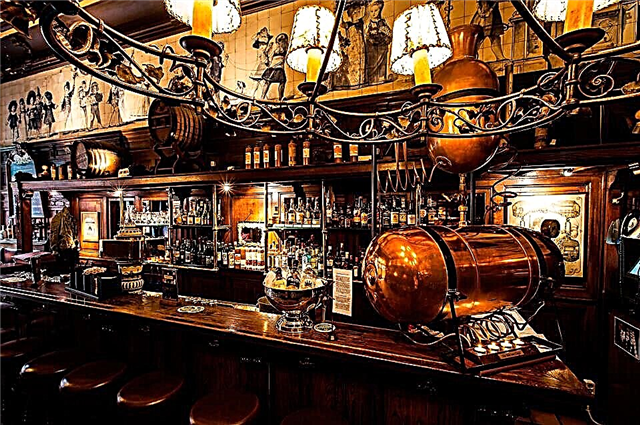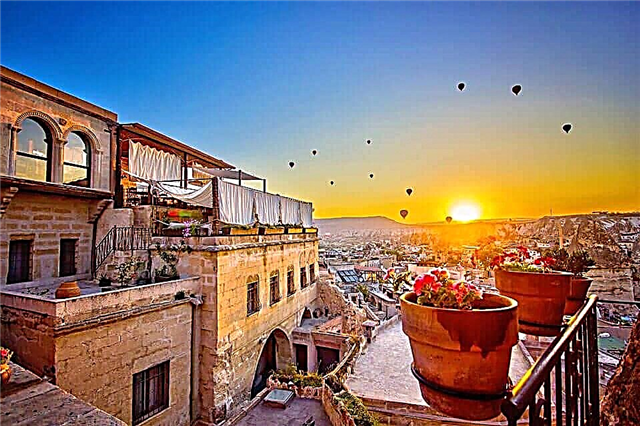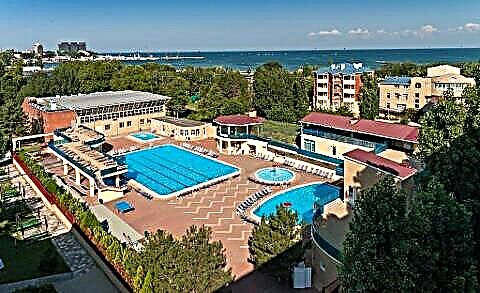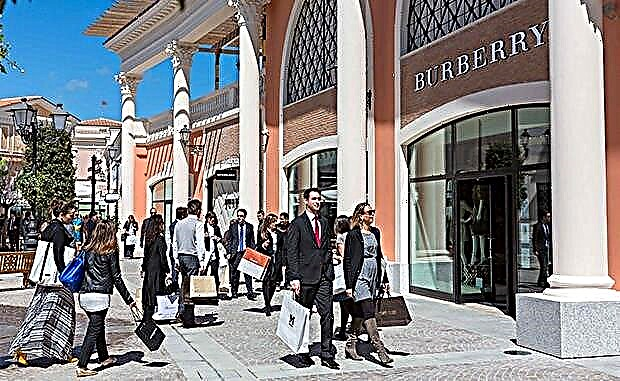Address: Russia, Yaroslavl region, Yaroslavl, st. Kedrova, 1a
Start of construction: 1635 year
Completion of construction: 1644 year
Coordinates: 57 ° 37'49.8 "N 39 ° 53'40.1" E
Content:
On the beautiful Volga embankment of Yaroslavl, there is a temple built in the 1640s. Previously, it was part of the estate and was surrounded by a wall connecting the Holy Gates, the gate church and the bell tower. The complex architectural composition of the temple, its amazingly beautiful decor, as well as expressive details make this cult building and the adjoining bell tower unique monuments of ancient Russian architecture.
History of the Church of the Nativity of Christ
For a long time on the banks of the Volga there was a wooden Christmas church. Her memory has survived in the history of the city as a place where Yaroslavl people hid in the Time of Troubles (1609) the miraculous image of Our Lady of Kazan, rescued from the Nativity Monastery.

Church of the Nativity of Christ
The first church in the Yaroslavl Posad was the Church of Nikola Nadein. After him, for a long time, they did not begin the construction of other posad temples. Researchers believe that the reason for this was the employment of Yaroslavl stonemasons in the construction of the Savior Cathedral. However, in 1636 it was decided to build a second stone church on the settlement.
The money for the new expensive construction site was allocated by the rich merchant family of the Nazarievs. It is noteworthy that both Nazariev brothers - Gury and Ankidin, who bore the nickname Druzhina, were members of the Yaroslavl people's militia, formed from the inhabitants of the city and the surrounding settlements in 1612. The merchants were known at the royal court and for their services to Russia during the war with the Polish-Lithuanian troops, they received the sovereign's certificate of honor.
The architectural plan of the new church was so grandiose that the church teachers did not have enough funds to fully implement it. And the construction was extended until 1644. The rich sons of Guria - Mikhail, Ivan and Andrey helped to complete it. They made significant adjustments to the original design, significantly expanding and complicating it.
The temple had five chapels. The first of them is a warm side-chapel located in the basement, in the northern part of the gallery. It was dedicated to St. Nicholas. The family's merchant affairs spread far beyond the borders of Yaroslavl, and the Nazarievs traveled a lot to other cities. They traded in Siberia, Kazan, Novgorod and Astrakhan. And Nicholas the Wonderworker was considered the patron saint of all travelers.

A stove decorated with green tiles was installed in this side-chapel for heating. It has not survived to this day, but several "antic" tiles are now in the funds of the Yaroslavl Museum. Above Nikolsky, a warm side-chapel was also built, dedicated to the apostles Peter and Paul.
The magnificent architectural ensemble that has grown on the Volga bank is unique. It had a very unusual and complex volumetric-spatial construction and asymmetric layout. Therefore, from any side, this church looked extremely picturesque. It was the pride of the entire settlement, because it was not built with the money of the tsar or the rich monastic treasury, as it was then customary. And at the expense of residents of the posad. Therefore, the Nativity Church later began to serve as a model for other township temples.
In 1683, the central part of the church was painted by Yaroslavl isographers, whose names remain unknown. However, according to art critics, the composition of the frescoes and the manner of painting indicate that they could have been made by the famous Yaroslavl masters Fyodor Ignatiev and Dmitry Semenov.
The documents of 1861 indicate that there were 295 parishioners at the temple. And the local icon of the Nativity of Christ was especially revered as bringing good luck to pregnant women.
During the Soviet years, the Orthodox Church was closed (1921) and then restored. In the 1930s, modern buildings were built around it, which largely distorted the spatial perception of the ancient architectural ensemble.

Bell tower of the Church of the Nativity of Christ
For many years the temple belongs to the city museum-reserve. There was always not enough museum money for restoration work, so they were carried out sporadically. In 1989, a major theft took place in the church - ancient icons were stolen from the iconostasis. As it turned out, the attackers sold them at an overseas auction. However, in 1995 these icons were bought by the Saratov collector Vladimir Roshchin. And he, having learned the fate of the ancient images, returned them to the museum collection for restoration and transfer back to the church.
Architecture and interior decoration of the Church of the Nativity of Christ
The temple consists of a main volume with five domes and a separately located bell tower, which played the role of the Holy Gates in the enclosure of the entire complex. The church itself has a high basement and is surrounded on three sides by a two-tiered gallery. You can climb it from the west, through an elegant house-like porch with a gable roof. The northern and southern parts of the gallery are equipped with temple chapels.

Bell tower of the Church of the Nativity of Christ view from the side
Interestingly, many of the architectural techniques used in the construction of this church were not used anywhere else. The temple looks picturesque from all sides, but its western facade stands out for its special beauty. Here, the pillars of the high basement are made in the form of expressive octagonal pillars. The wide cornice, which separates the zakomaras, and the laconic arcature belts on the drums of the church domes also look great. Some features of the building give out the work of masters at the initial stage of Yaroslavl architecture. In those days, builders did not use patterns, so the arches on the galleries of the church do not yet have a clear drawing.
The decor of the temple is considered unique, first of all, because the architects of Yaroslavl used polychrome glazed tiles in it for the first time. On the facades of the bell tower, galleries and porch, ceramics of various shapes are used - ribbons, intricate rectangles and rosettes. And brightly colored tiles covered the church chapters.
A noteworthy temple-created inscription was also composed of ceramic tiles, which has survived to this day. It encircles the main volume of the church along the facades and is located under the base of the zakomar. It is believed that this inscription cost the merchants a lot of money, since each of its syllables demanded a separate cliche from the craftsmen. Here the names of Tsar Mikhail Fedorovich, Metropolitan Varlaam of Rostov, as well as the names of all ktitors - Guria and the Nazarev Druzhina and the three heirs of Guria, whose labors completed the construction, are immortalized. This is perhaps the first time in history when the names of merchant class people who were not born at that time were included in the inscription in the temple. Later, in order to make the letters more visible and stand out brighter against a white background, they were repeatedly painted with oil paints.

The church was overhauled several times. And today it has come down to us without four side chapters on the main volume and without a steep arcade that once connected the building of the bell tower with the quadrangle. In addition, the original podzakomarnoe cover, according to tradition, was converted to a more practical four-slope. The temple iconostasis was also changed several times, but several of the very first icons were preserved. Therefore, today the Nativity Church is the only icon-painting temple ensemble that has survived in the city from the first half of the 17th century.
The pillar-shaped church bell tower, which has no analogues in ancient Russian architecture, is very remarkable. It has a rectangular base, a richly decorated ringing tier and a hipped roof, the total height of which exceeds 38 m.This iconic building played several roles at once - a belfry, an entrance gate, a small church "under the bells", as well as a clock tower. A complex system of staircases was arranged inside the bell tower.
On both sides of the central tent, there are two graceful turrets on the bell tower, also crowned with small tents. Such a composition emphasizes the aspiration of the entire building upward. In the tent of the bell tower, skylights are cut through - lucarnes, which are framed with beautiful volumetric platbands. Particularly interesting, nowhere else, an element of decor, are the paired columns located on the western facade, which look like small minarets.

Bell tower of the Church of the Nativity of Christ view from the rear
Preserved information that at the beginning of the XX century there were 8 bells on the belfry. The oldest of them were cast by Dutch craftsmen in the middle of the 17th century. And the largest bell weighed about 100 pounds. However, during the struggle of the Soviet regime with religion, these bells were removed and melted down.
The current state of the temple and the visiting regime
The Nativity Church is a branch of the Yaroslavl Museum-Reserve, and sometimes church services are held there. The temple is open daily, except Monday and Tuesday, from 10.00 to 17.00. You can get here only by preliminary requests, left by calling the museum +7 (4852) 303869.
How to get to the Church of the Nativity of Christ
The church is located on the Volzhskaya embankment of the city - st. Kedrov, 1.
By car. The federal highway M8 leads from Moscow to Yaroslavl. Within the city limits, it is called Moskovsky Prospekt. You need to cross the Korotosl River along it, and after the bridge turn right to Korotosl Embankment. This embankment leads to the bank of the Volga - the Volzhskaya embankment, along which the temple is 1.1 km away.

Church of the Nativity of Christ view from the Bell Tower
By train. From Moscow to Yaroslavl, express train trains reach in 3 hours 16 minutes. The journey by regular train takes from 4 to 5.5 hours. From Moskovsky Train Station in Yaroslavl, the distance to the Rozhdestvenskaya Church is 3.9 km. You can walk to it, as well as take a taxi.











